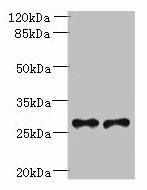Description
| Antibody Name: | Trem2 Antibody (PACO30798) |
| Antibody SKU: | PACO30798 |
| Size: | 50ug |
| Host Species: | Rabbit |
| Tested Applications: | ELISA, WB |
| Recommended Dilutions: | ELISA:1:2000-1:10000, WB:1:500-1:2000 |
| Species Reactivity: | Mouse, Human |
| Immunogen: | Recombinant Mouse Triggering receptor expressed on myeloid cells 2 protein (19-171AA) |
| Form: | Liquid |
| Storage Buffer: | Preservative: 0.03% Proclin 300 Constituents: 50% Glycerol, 0.01M PBS, PH 7.4 |
| Purification Method: | >95%, Protein G purified |
| Clonality: | Polyclonal |
| Isotype: | IgG |
| Conjugate: | Non-conjugated |
 | Western blot All lanes: Trem2 antibody at 6µg/ml Lane 1: Mouse liver tissue Lane 2: THP-1 whole cell lysate Secondary Goat polyclonal to rabbit IgG at 1/10000 dilution Predicted band size: 25, 28 kDa Observed band size: 28 kDa . |
| Background: | May have a role in chronic inflammations and may stimulate production of constitutive rather than inflammatory chemokines and cytokines. Forms a receptor signaling complex with TYROBP and triggers activation of the immune responses in macrophages and dendritic cells. |
| Synonyms: | Triggering receptor expressed on myeloid cells 2 (TREM-2) (Triggering receptor expressed on monocytes 2), Trem2, Trem2a Trem2b Trem2c |
| UniProt Protein Function: | TREM2: May have a role in chronic inflammations and may stimulate production of constitutive rather than inflammatory chemokines and cytokines. Forms a receptor signaling complex with TYROBP and triggers activation of the immune responses in macrophages and dendritic cells. Defects in TREM2 are a cause of polycystic lipomembranous osteodysplasia with sclerosing leukoencephalopathy (PLOSL); also known as presenile dementia with bone cysts or Nasu-Hakola disease (NHD). PLOSL is a recessively inherited disease characterized by a combination of psychotic symptoms rapidly progressing to presenile dementia and bone cysts restricted to wrists and ankles. PLOSL has a global distribution, although most of the patients have been diagnosed in Finland and Japan, with an estimated population prevalence of 2x10(-6) in the Finns. 3 isoforms of the human protein are produced by alternative splicing. |
| UniProt Protein Details: | Protein type:Membrane protein, integral Cellular Component: integral to membrane; intracellular membrane-bound organelle Molecular Function:lipopolysaccharide binding; peptidoglycan binding; protein binding; transmembrane receptor activity Biological Process: detection of lipopolysaccharide; detection of peptidoglycan; innate immune response; lipopolysaccharide-mediated signaling pathway; phagocytosis, engulfment; positive regulation of antigen processing and presentation of peptide antigen via MHC class II; positive regulation of calcium-mediated signaling; positive regulation of peptidyl-tyrosine phosphorylation |
| NCBI Summary: | The protein encoded by this gene is part of the immunoglobulin and lectin-like superfamily and functions as part of the innate immune system. This gene forms part of a cluster of genes on mouse chromosome 17 thought to be involved in innate immunity. This protein associates with the adaptor protein Dap-12 and recruits several factors, such as kinases and phospholipase C-gamma, to form a receptor signaling complex that activates myeloid cells, including dendritic cells and microglia. In humans homozygous loss-of-function mutations in this gene cause Nasu-Hakola disease and mutations in this gene may be risk factors to the development of Alzheimer's disease. In mouse mutations of this gene serve as a pathophysiological model for polycystic lipomembranous osteodysplasia with sclerosing leukoencephalopathy (Nasu-Hakola disease) and for inflammatory bowel disease. Alternative splicing results in multiple transcript variants that encode different protein isoforms. [provided by RefSeq, Jan 2013] |
| UniProt Code: | Q99NH8 |
| NCBI GenInfo Identifier: | 50401660 |
| NCBI Gene ID: | 83433 |
| NCBI Accession: | Q99NH8.1 |
| UniProt Secondary Accession: | Q99NH8,Q8CGK4, Q8CIA6, Q99NH9, Q9JL34, |
| UniProt Related Accession: | Q99NH8 |
| Molecular Weight: | 27,304 Da |
| NCBI Full Name: | Triggering receptor expressed on myeloid cells 2 |
| NCBI Synonym Full Names: | triggering receptor expressed on myeloid cells 2 |
| NCBI Official Symbol: | Trem2 |
| NCBI Official Synonym Symbols: | TREM-2; Trem2a; Trem2b; Trem2c |
| NCBI Protein Information: | triggering receptor expressed on myeloid cells 2 |
| UniProt Protein Name: | Triggering receptor expressed on myeloid cells 2 |
| UniProt Synonym Protein Names: | Triggering receptor expressed on monocytes 2 |
| Protein Family: | Triggering receptor expressed on myeloid cells |
| UniProt Gene Name: | Trem2 |
| UniProt Entry Name: | TREM2_MOUSE |






